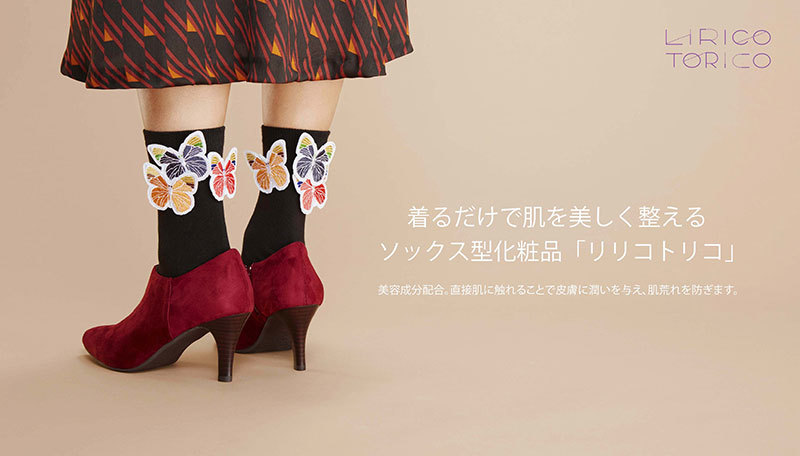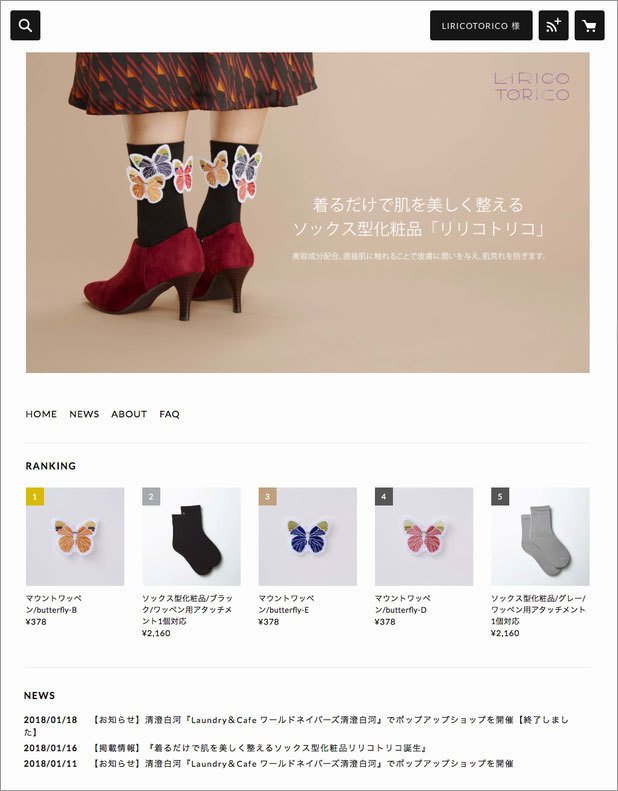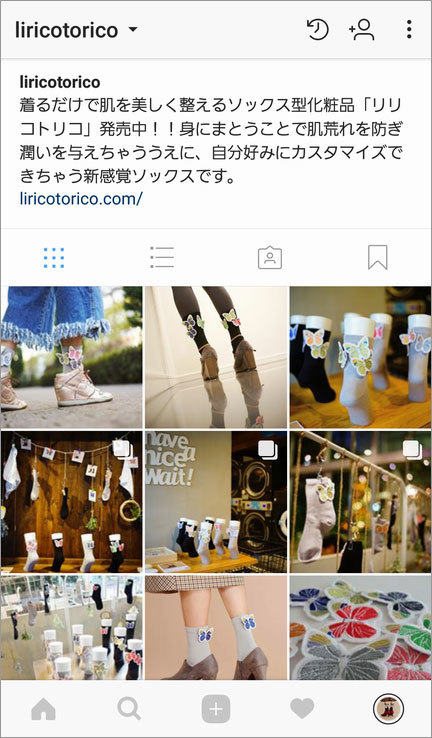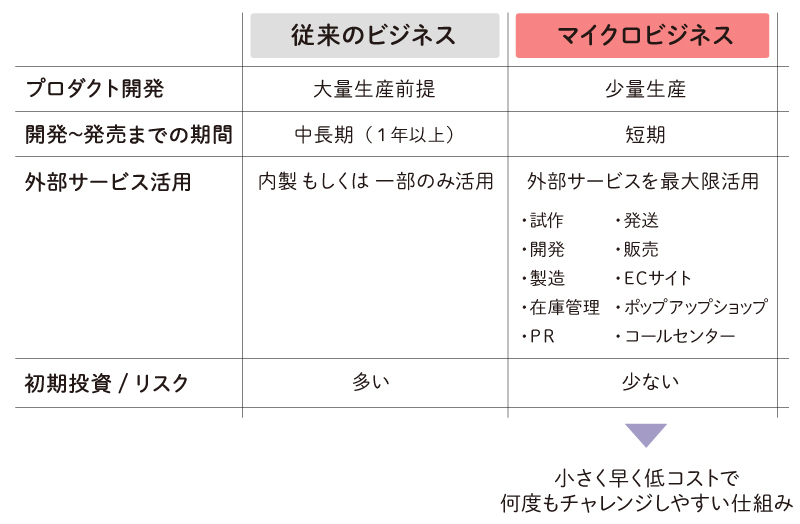Focusing on materials to create new value. That is Dentsu Inc.'s "Material Innovation" project. By effectively and impressively cutting up the innovative characteristics of new functional materials using the creative power of an advertising agency, we develop new applications and usage scenarios. We will convey the appeal and features of Material Innovation.
Launching a Project to Transform Hidden "New Functional Materials" into Compelling Products
What we practice in the "Material Innovation" project is discovering new functional materials that were previously only used for B2B applications or had been developed but remained buried without commercialization, and launching them as B2C products.
A key feature is our approach: Dentsu Inc. actively handles productization and sales, moving beyond mere proposals or planning to prove their viability.
As the first commercialized product from this project, in December 2017, Dentsu ScienceJam Inc. launched "Lirikotriko"—a sock-type cosmetic that beautifies skin simply by wearing it.
This time, we will introduce the process from the start of planning this product to its actual launch.
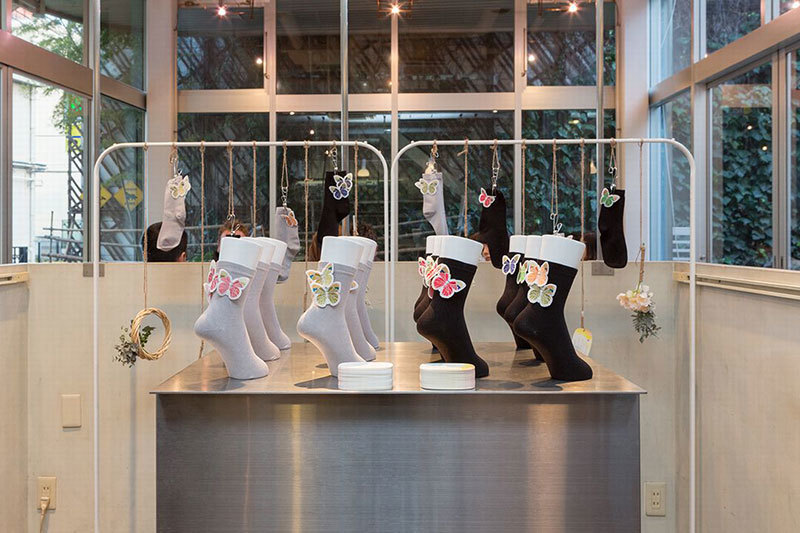
Sock-Type Cosmetic "Lirikotiriko"
Discovering "Raffinan," a New Functional Material That Maintains Skin's Mildly Acidic pH Just by Wearing It
Lirikotriko socks utilize "Raffinan," a new functional material developed by Teijin Frontier.
This Raffinan is Japan's first※ "wearable cosmetic" that prevents skin irritation and moisturizes the skin when worn.
*As an innerwear-type cosmetic
My encounter with Raffinan is connected to my background as a product designer.
In product design, there's a specialized field called "CMF" (Color, Material, Finish) that focuses on designing the material itself, its color, texture, and finish. As a product designer habitually gathering new CMF information daily, I came across Raffinan featured in a textile trade publication.
[Features of Raffinan]
- ・Japan's first wearable cosmetic (Cosmetic Manufacturing and Sales Notification Filed)
- ・Prevents skin irritation and moisturizes the skin
- ・Machine washable like regular clothing
The key point as a material is its inclusion of malic acid. What exactly is malic acid?
Generally, healthy human skin maintains a "mildly acidic" pH (hydrogen ion index) of 4.5 to 6.0 on its surface. Sweating or prolonged dryness can cause the skin surface to shift toward "alkaline," potentially leading to skin problems.
Conversely, maintaining a weakly acidic skin surface helps prevent bacterial growth, shields against external irritants, and reduces moisture evaporation.
Malic acid has the effect of regulating the pH of human skin to a mildly acidic state . Raffinane prevents skin roughness and moisturizes the skin through the power of malic acid.
After much trial and error, we arrived at "sock-type cosmetics" and "butterfly patches."
"A cosmetic in a fiber? What an innovative material!"
Immediately intrigued, I promptly contacted Teijin Frontier, the developer, and requested an introduction to the material. This was in January 2017.
At that point, while Raffinan was revolutionary as a material, all commercialized products emphasized "functional value" like innerwear.
We felt it lacked sufficient "emotional value" – the kind of item women would use daily as a fashion accessory or show off to others. So, we decided to plan a product that leveraged the unique functional value of "wearable cosmetics" while also incorporating emotional value.
For this Raffinan project, I served as Project Leader handling project management. Planning was led by Yoko Kibata from the Marketing Solutions Bureau, and Art Direction was handled by Umoe Endo from the Creative Planning Division 4. Three female employees worked together on this.
Leveraging Raffinan's characteristic of delivering effects when worn, we initially planned "tights" for women as a product that "adheres closely over a large area for extended periods." However, we discovered that forming tights was difficult due to material properties, leading us to change the plan to "socks" midway.
That said, material constraints again posed challenges for the socks: color selection was limited, and even adding patterns proved difficult.
Furthermore, as a cosmetic product, there are various legal restrictions. For example, the sock itself, classified as a "cosmetic," cannot undergo decorative processing like printing that might affect the cosmetic ingredients.
The inability to create variations using the key design elements of "color," "pattern," and "print" made it extremely difficult to add the emotional value that makes someone think, "Oh, I want these."
Within these limitations, the mechanism we arrived at to appeal to the senses was the idea of "providing separately sold mount patches that can be personalized to the purchaser's preferences, and attaching a patch attachment to the socks."
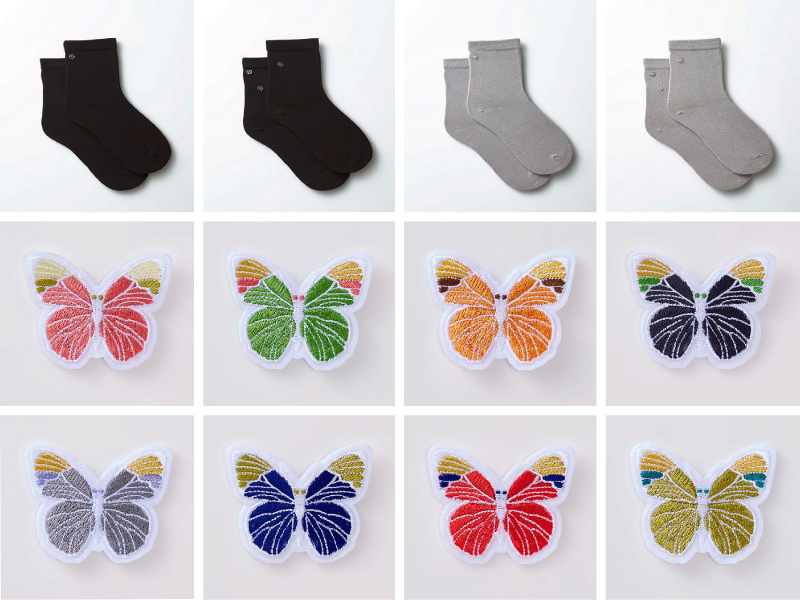
Socks come in two colors. Attachments allow you to add butterfly mount patches.
The patch motif is a butterfly, cute when perched on the foot, also embodying the butterfly effect—a small innovation that creates a ripple effect in daily life.
Socks are an everyday analog item used by everyone. What kind of innovation can come from using Raffinan on such socks?
■Case 1: For those who say, "I've been too busy lately to take care of my skin"
→ Achieve "skincare while wearing"—beautifully conditioned skin just by wearing them.
■Case 2: For those who always apply cream before putting on socks at night
→ You can skip that extra step of applying cream.
The concept is "effortless, enjoyable care." This time, we aimed to bring truly small, simple innovations into everyday life.
How about a "micro business"—small, fast, and low-cost?
While Lirikotiriko as a product was born through the process described above, there's another unique aspect of this project we'd like to share.
The Lilico Torico project is not client work. As a Dentsu ScienceJam Inc. initiative, we handled everything ourselves—from product planning and PR to sales on our e-commerce site, pop-up shops, packaging, shipping, and inventory management.
Of course, we didn't just create and sell it; we carefully set the sales price based on a projected project payline that ensures profitability.
This time, with a particular focus on new functional materials, we achieved low-volume, low-cost production and reduced after-sales service burdens by designing the product to "not use molds," "not require communication," and "not require electricity."
For our e-commerce site, inventory management, and pop-up shop operations, we adopted a strategy of combining and utilizing various existing open and low-cost services.
Create products small, fast, and as low-cost as possible. Rather than prototyping, sell them for real and leverage raw user feedback. This mechanism and approach itself is a new initiative. We essentially created a "micro-business" scheme.
This microbusiness model serves as an experimental case for manufacturing outside traditional manufacturers and conducting business. It also aligns with the needs of large corporations seeking to "launch new ventures as small and quickly as possible."
The "Material Innovation" project will continue advancing the commercialization of new functional materials.
Finally, in response to customer requests for "selling socks and patches as a set," Ririkotrico is launching a White Day gift set starting February 19th. Check our e-commerce site for details!
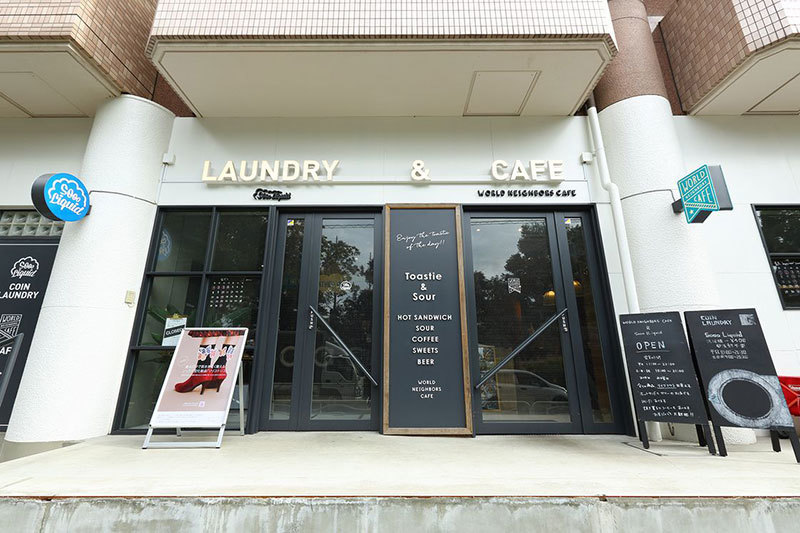
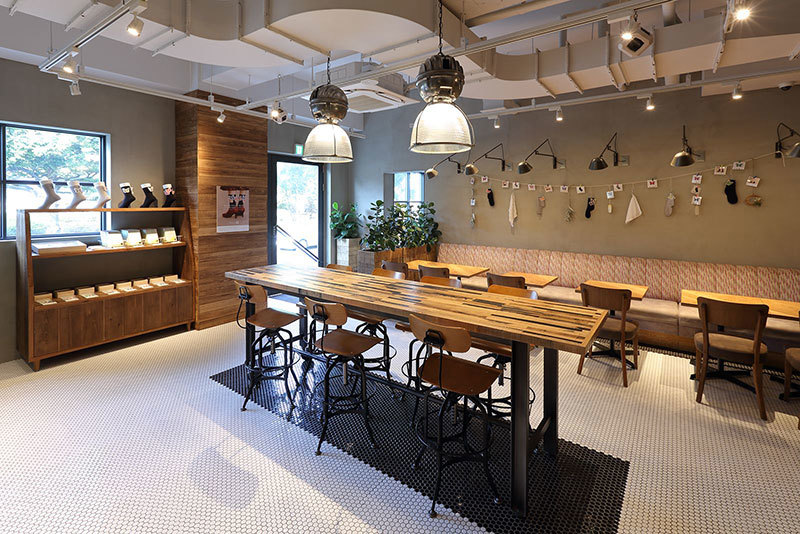
Scene from the pop-up shop held at "Laundry & Cafe World Neighbors Kiyosumi Shirakawa" in Kiyosumi Shirakawa, January 18-20, 2018

